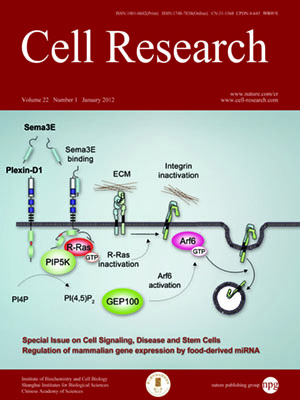
Volume 22, No 1, Jan 2012
ISSN: 1001-0602
EISSN: 1748-7838 2018
impact factor 17.848*
(Clarivate Analytics, 2019)
Volume 22 Issue 1, January 2012: 259-272
ORIGINAL ARTICLES
The critical role of CD133+CD44+/high tumor cells in hematogenous metastasis of liver cancers
Ying Hou1,2,*, Qifei Zou3,*, Ruiliang Ge3, Feng Shen3 and Yizheng Wang1
1State Key Laboratory of Neuroscience, Institute of Neuroscience, Shanghai Institutes for Biological Sciences, 320 Yueyang Road, Shanghai 200031, China
2Graduate School, The Chinese Academy of Sciences
3Eastern Hepatobiliary Surgery Hospital, Second Military Medical University, 225 Changhai Road, Shanghai 200438, China
Correspondence: Yizheng Wang, Feng Shen,(yzwang@ion.ac.cn; shenfengdfgd@yahoo.com.cn)
Metastatic hepatocellular carcinoma (HCC) is one of the most lethal cancers worldwide. However, the cell population responsible for its metastasis remains largely unknown. Here, we reported that CD133
+CD44
+/high defined a subgroup of tumor cells that was responsible for hematogenous metastasis of liver cancers. Immunohistochemical investigation of human HCC specimens revealed that the number of CD133
+ and CD44
+ HCC cells was increased and was associated with portal vein invasion. Purified CD133
+ or CD44
high HCC cells were superior in clonogenic growth and vascular invasion, respectively. Thus, the combination of CD133 and CD44 was used to define a novel HCC sub-population. CD133
+CD44
high, but not CD133
+CD44
low/−, CD133
−CD44
high or CD133
−CD44
low/− xenografts, produced intrahepatic or lung metastasis in nude mice. Further analysis of human HCC samples by flow cytometry showed that the number of CD133
+CD44
+ tumor cells was associated with portal vein metastasis. The cDNA microarray analysis of CD133
+CD44
+ and CD133
+CD44
− tumor cells isolated from metastatic HCC patients revealed that these cells comprised of two different populations possessing distinct gene expression profiles. Our results suggest that CD133
+CD44
+ tumor cells are a particular population responsible for hematogenous metastasis in liver cancers and that these cells might be targets for treatment of HCC metastasis.
Cell Research (2012) 22:259-272. doi:10.1038/cr.2011.139; published online 23 August 2011
FULL TEXT | PDF
Browse 2370


